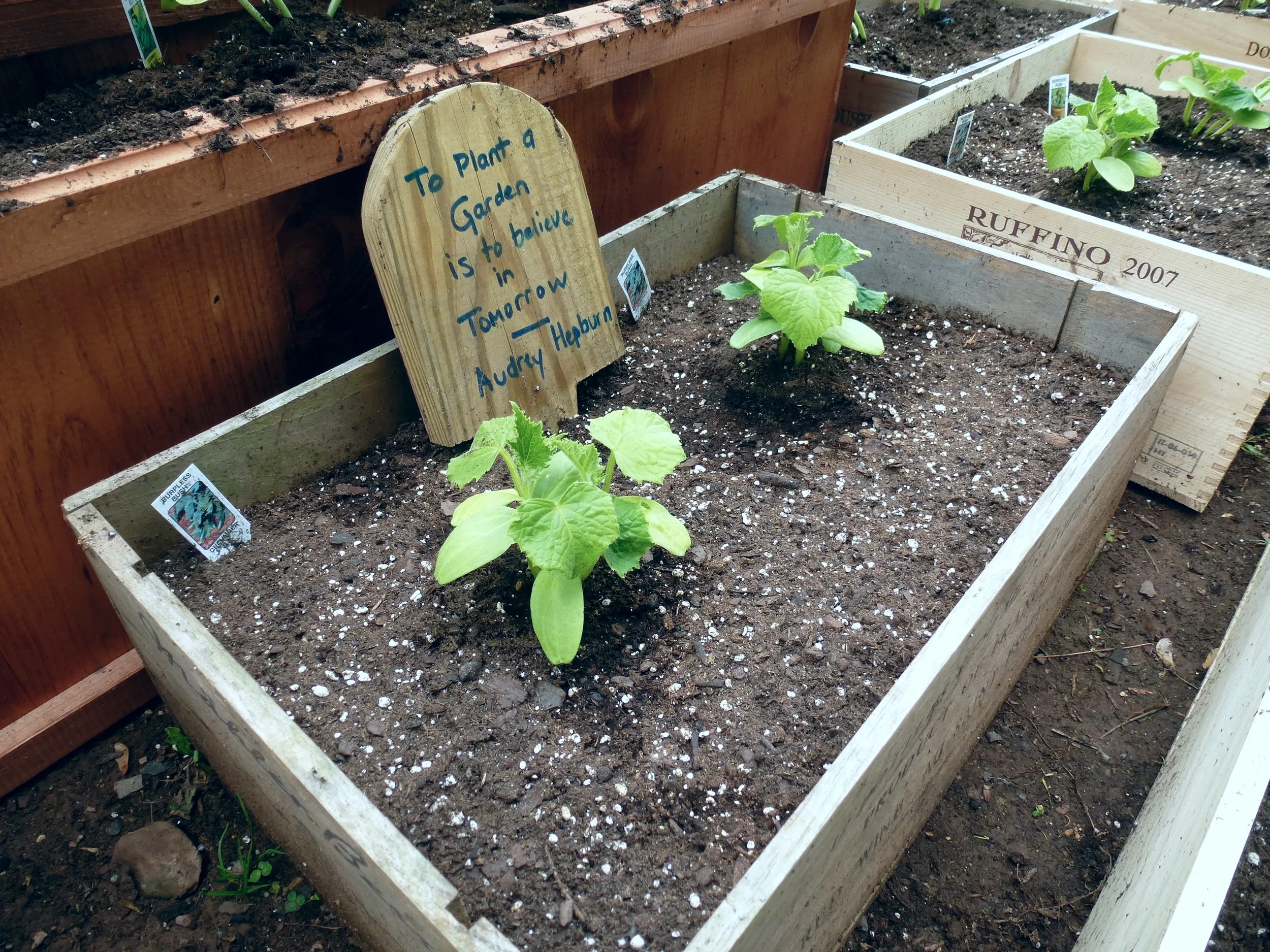Starting a School Garden
In the last half century or so, we have become more disconnected from our food sources. We no longer are restricted by seasonal availability of food as large supermarkets can get globally-sourced produce throughout the year. In our busy lives, we often enjoy the convenience of prepared and packaged food items. In some ways, this luxury has made our lives easier and in other ways, it removes us from knowing our growers and producers and how the food on our table came to be. If adults are removed from the source, I can only imagine how disconnected children must be.
Certainly there are benefits to this current state - I'm pretty happy that I can get berries year round rather than be restricted only to when they grow in my area. But, I know they'll be fresher when I can get them in season locally from a grower nearby. Of course, there are also major benefits of global food trade for developing nations to reduce hunger and poverty. To be clear - there's a difference between preferring to connect with locally-sourced food vs. the reliance on expanded food sources for basic nutrition and sustenance. This post is not about the latter.
Where Does Food Come From?
I've heard a lot of parents say that their kids don't really know where food comes from. Many try to expose their kids to farms through a visit or even to farmers markets. Whether it's the eggs that come from a chicken or the beans that get pulled from their stalks, there's something meaningful about understanding how the food we eat was grown or raised. It should be fundamental to know that the actual source of food isn't "the grocery store." Maybe understanding food sources makes us think more about what we eat. Hopefully it inspires some of us to grow our own food, whether in our own backyard or the schoolyard. I think that growing food in a garden at a young age can have a long-term benefit through one's life.
Benefits of School Gardening Programs
School gardening programs are on the rise in the US (with some regional and socioeconomic disparities). Community-based school gardening programs help kids not only understand where food comes from, but have been shown to have a positive impact on nutritional choices and academic performance, as well as physical, social and emotional health. Knowing the impact gardening has had on me, personally, I was so pleased to see that our local elementary schools take part in school gardening programs. On my morning run, I often pass one of them at Clinton Elementary School in Maplewood, NJ. I was curious about the program and asked PTA member and school garden champion, Anne Harding, to help me understand what it takes to put a garden like this together and offer tips for others who might want to get started at their school. (Anne is also a local grower and owner of Annie's Flower Farm. Check out her beautiful flowers at the South Orange Farmers Market starting in June.)
Starting a School Garden - A Champion and Funding
Based on the Clinton Elementary story, it seems like the very first thing you need is a champion for the idea. In this case, that was Anne herself. As PTA member and school newsletter editor, she raised the idea at a meeting back in 2012 and got the green light and support from then PTA president, Elizabeth Aaron (now principal of our local high school.) In addition to the good fortune of having 6 small beds donated by a parent, the PTA supported the effort with money to pay for dirt, compost and tools - about $200 to get started. (No money from the school or the district was obtained for the garden.)
TIP: Solicit local garden centers and local merchants for donations and discounts. In Clinton's case, even Home Depot donated wooden bed supplies when they heard it was going to a school garden.
In addition to local merchant donations, be sure to check out school garden grants. Clinton received a $2000 grant from Whole Foods last year that helped them expand their garden to build 12 new beds.
TIP: Seek talent among parents who have skills outside of gardening. Some may have experience with grant writing, others with marketing (to help make a case for budget and support), some may be great communicators and can make the pitch to the PTA or principal. Lots of talents can contribute to the effort.
A quick Internet search revealed many different opportunities to apply for school garden grants. In addition to the Whole Foods Kids Foundation, there are other grant resources, including:
Garden ABCs
KidsGardening.org
Annie's Grants for Gardens
Education Outside
Check out Additional Resources at the end of this post.
Calling all Volunteers!
The next thing you need is the ability to rally the parental troops. For Clinton, they have (successfully) called on parent volunteers to help build beds and fill them. This year, they're involving teachers at the beginning of the season to "adopt" a bed for their classrooms and will get the kids involved in doing their own bed maintenance and projects. They're trying to integrate garden projects for each grade that fit their curriculum and can help give focus to make it easier for teachers to plan.
TIP: Teachers have a lot on their plates. When proposing garden projects, try to make it as fun as possible and work with them to figure out how this can fit within their current curriculum and programs. Ask them if they're interested and talk with them about what it involves so they can plan appropriately.
Project Ideas
Kids (of all ages) love to garden. They love the chance to get out of the classroom, get their hands in the dirt and handle plants and seeds. Tasting the crops they've grown is really exciting. Want your kids to eat more kale? Have them grow it and you're sure to find success.
TIP: If you're bringing an entire class or a large group of kids out to garden, see if you can get parent volunteers to help with the logistics and keep order. If possible, have a "point parent" for each grade to coordinate. If possible, bring smaller groups out for a less chaotic adventure in the garden.
A few ideas that may find their way to Clinton's gardens this year (to hopefully spark some ideas of your own):
- Kindergartners: Butterfly garden
- First-graders: Peas
- Second-graders: Salad garden (different kinds of lettuces and radishes with a "salad party" in the classroom at harvest time).
- Third-graders: Grow potatoes for the local food pantry or grow the Native Americans' "three sisters" crops: corn, beans and squash.
TIP: When planning gardens, keep in mind that certain vegetables won't be available until after the school year has ended (e.g., tomatoes). It doesn't mean you shouldn't plant them, but for projects that involve harvesting, keep this in mind. Clinton actually offered late harvest foods for free to those who volunteered to care for the garden in summer and brought surplus food to a local food pantry.
On the most part, much of the food is harvested and eaten by the kids, reinforcing the understanding of where their food comes from and giving some to others reinforces their sense of community.
Challenges
Let's face it, most things that are worthwhile present at least a few challenges. Here are a few to keep in mind and try to manage:
- Water. Clinton Elementary utilizes rain barrels for water collection and the kids love using them. But, they found that the rain barrels don't necessarily work well without being connected to a downspout. Gutters have gotten clogged with leaves and you don't necessarily want to use runoff water from a roof when watering edible plants. This year, Anne said that they're going to try using a giant funnel to catch rainwater and direct it to the barrels for a good source of fresh water.
- Commitment. Teachers, parents and kids need to be committed to the project. Gardening can be lots of (rewarding) work. Try to keep everyone's momentum going throughout the season.
- Summer. While this is not normally a problem for most gardeners, having a garden at a school that breaks for summer can present a challenge. Get people to sign up for garden care in the summer with the reward of being able to pick food for themselves. Before the school year ends, solicit sign ups for a week or two each of garden care from school or neighborhood families.
Helpful Hints
Thanks to Anne Harding for sharing her experiences with Clinton Elementary School's garden with me. Here are a few helpful tips for those who would like to get started on their school gardens:
- Do your research. You may need to present costs and set expectations when getting approval to begin at your school. Talk to local gardeners and garden centers in your area to understand costs and what might be donated. Having as much information as possible will make your case stronger.
- Find allies. No one can do this by themselves and you have to have buy-in from teachers, the PTA, principal and parents. There needs to be a strong support system in place to pitch in when needs arise (both planned and unplanned).
- Find funding. Home Depot made a donation to the Clinton garden that helped get them started. Talk to your local garden supply stores and nurseries who may be willing to donate materials or money to help the cause.
- Embrace the learning process. Like every gardener, you'll make mistakes. I have my own crops fail; same thing will happen at a school garden. Learn from it and help the kids learn from it. It actually gives insight into what food producers go through themselves.
- Keep it simple. Don't get overambitious, particularly as you get started. There are materials out there to help you plan, but keep the projects per grade small and achievable and don't bombard teachers and students will tons of email and reading material to go through. Partner with them along the way as much as possible to make learning a process, not a burden.
- Don't take reactions personally. If you're the garden champion, you may find that some teachers and parents will be more excited than others at the opportunity to participate in a school garden. Don't take anyone's lack of enthusiasm personally - it's not for everyone.
Additional Resources
Education Outside - How to Start a School Garden
KidsGardening.org - Starting a School Garden
LetsMove.gov - School Garden Checklist
Ecoliteracy.org - A Guide for Creating School Gardens as Outdoor Classrooms





